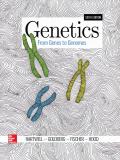
a.
To determine:
The basis for tRNA synthetase genes in B. subtilis regulated by T-box RNA leaders.
Introduction:
The promoter of the lac operon functions as the binding site for RNA polymerase. The RNA polymerase enzyme performs the function of transcription. The operator acts as a negative regulatory site and forms complex with lac repressor protein. The operator passes over the promoter, and when the repressor is bound then the RNA polymerase is not able to bind with the promoter and thus, starts transcription.
b.
To determine:
The alteration in the tyrS T-box leader so that it can respond to the uncharged tRNAPhe instead of tRNATyr.
Introduction:
DNA is the genetic material of all organisms except some viruses.
c.
To determine:
A change in the interaction of the 5’ UAC 3’ codon when it was changed to 5’ CUA 3’.
Introduction:
The codons are a set of three nucleotides that encode for a specific amino acid. There are a total of 64 codons that can account for 20 amino acids. The amino acid tyrosine is encoded by only one amino acid.
d.
To determine:
The gene mutation that can make the mutant T-box RNA leader functional again.
Introduction:
The process of DNA replication is the process by which the genetic material of the organism copies itself to be distributed among the daughter cells during cell division. The DNA replication takes place before the cell division and prepares the cell for mitosis and meiosis. This process is followed by transcription and translation.
e.
To determine:
The effect on beta-galactosidase when the levels of tyrosine are high and low.
Introduction:
Proteins are the long chains of amino acids that are present in a specific sequence in the cell. These protein are synthesized by mRNA inside the nucleus and then transported into the cytoplasm where they undergo post-translational modifications.
f.
To determine:
The effect on beta-galactosidase when the levels of tyrosine are high and low when the mutation takes place in the tRNA gene.
Introduction:
The process of DNA replication is the process by which the genetic material of the organism copies itself to be distributed among the daughter cells during cell division. The DNA replication results in the production of multiple copies of DNA that is distributed among daughter cells.
g.
To determine:
The search criteria for T-box regulators.
Introduction:
The process of DNA replication is the process by which the genetic material of the organism copies itself to be distributed among the daughter cells during cell division. The DNA replication takes place before the cell division and prepares the cell for mitosis and meiosis. This process is followed by transcription and translation.
Want to see the full answer?
Check out a sample textbook solution
Chapter 16 Solutions
EBK GENETICS: FROM GENES TO GENOMES
- please fill in missing parts , thank youarrow_forwardplease draw in the answers, thank youarrow_forwarda. On this first grid, assume that the DNA and RNA templates are read left to right. DNA DNA mRNA codon tRNA anticodon polypeptide _strand strand C с A T G A U G C A TRP b. Now do this AGAIN assuming that the DNA and RNA templates are read right to left. DNA DNA strand strand C mRNA codon tRNA anticodon polypeptide 0 A T G A U G с A TRParrow_forward
- Please identify the curve shown below. What does this curve represent? Please identify A, B, C, D, and E (the orange oval). What is occurring in these regions?arrow_forwardPlease identify the test shown here. 1) What is the test? 2) What does the test indicate? How is it performed? What is CX? 3) Why might the test be performed in a clinical setting? GEN CZ CX CPZ PTZ CACarrow_forwardDetermine how much ATP would a cell produce when using fermentation of a 50 mM glucose solution?arrow_forward
- Determine how much ATP would a cell produce when using aerobic respiration of a 7 mM glucose solution?arrow_forwardDetermine how much ATP would a cell produce when using aerobic respiration to degrade one small protein molecule into 12 molecules of malic acid, how many ATP would that cell make? Malic acid is an intermediate in the Krebs cycle. Assume there is no other carbon source and no acetyl-CoA.arrow_forwardIdentify each of the major endocrine glandsarrow_forward
 Biology (MindTap Course List)BiologyISBN:9781337392938Author:Eldra Solomon, Charles Martin, Diana W. Martin, Linda R. BergPublisher:Cengage Learning
Biology (MindTap Course List)BiologyISBN:9781337392938Author:Eldra Solomon, Charles Martin, Diana W. Martin, Linda R. BergPublisher:Cengage Learning Human Heredity: Principles and Issues (MindTap Co...BiologyISBN:9781305251052Author:Michael CummingsPublisher:Cengage Learning
Human Heredity: Principles and Issues (MindTap Co...BiologyISBN:9781305251052Author:Michael CummingsPublisher:Cengage Learning Biology Today and Tomorrow without Physiology (Mi...BiologyISBN:9781305117396Author:Cecie Starr, Christine Evers, Lisa StarrPublisher:Cengage Learning
Biology Today and Tomorrow without Physiology (Mi...BiologyISBN:9781305117396Author:Cecie Starr, Christine Evers, Lisa StarrPublisher:Cengage Learning Biology: The Dynamic Science (MindTap Course List)BiologyISBN:9781305389892Author:Peter J. Russell, Paul E. Hertz, Beverly McMillanPublisher:Cengage Learning
Biology: The Dynamic Science (MindTap Course List)BiologyISBN:9781305389892Author:Peter J. Russell, Paul E. Hertz, Beverly McMillanPublisher:Cengage Learning BiochemistryBiochemistryISBN:9781305577206Author:Reginald H. Garrett, Charles M. GrishamPublisher:Cengage Learning
BiochemistryBiochemistryISBN:9781305577206Author:Reginald H. Garrett, Charles M. GrishamPublisher:Cengage Learning Biology 2eBiologyISBN:9781947172517Author:Matthew Douglas, Jung Choi, Mary Ann ClarkPublisher:OpenStax
Biology 2eBiologyISBN:9781947172517Author:Matthew Douglas, Jung Choi, Mary Ann ClarkPublisher:OpenStax





